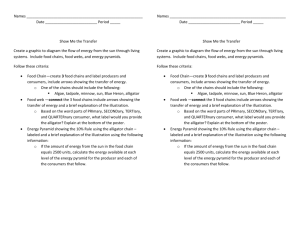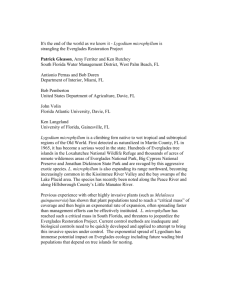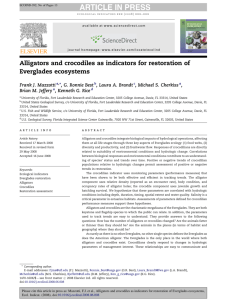The ATLSS American Alligator Population Model: Results from
advertisement
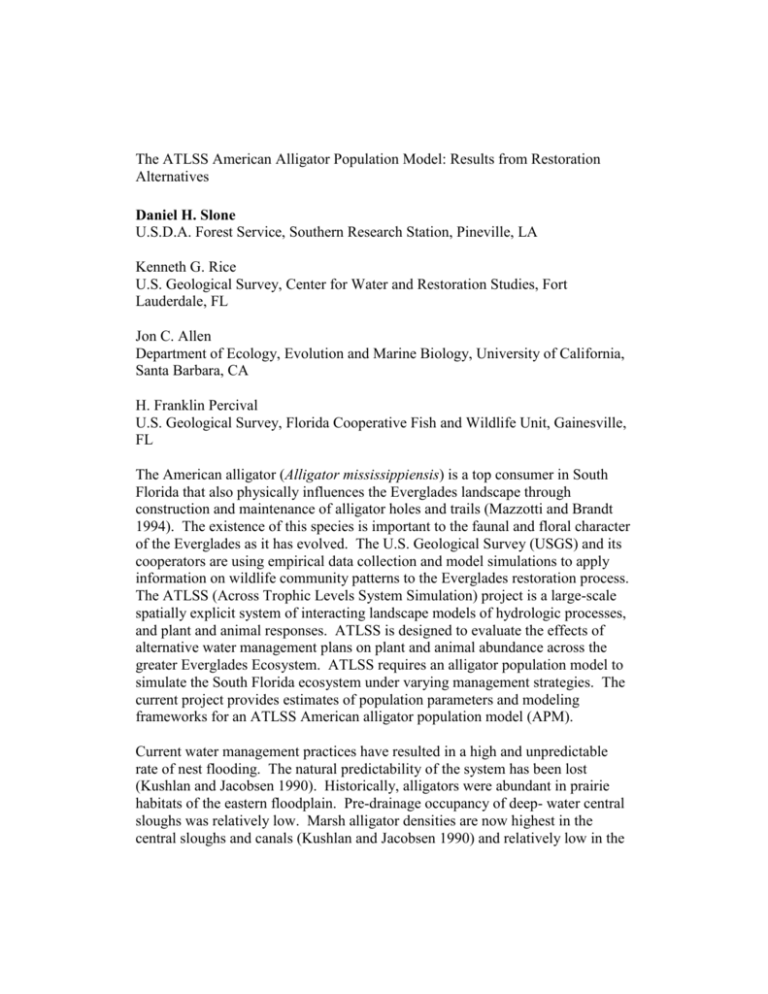
The ATLSS American Alligator Population Model: Results from Restoration Alternatives Daniel H. Slone U.S.D.A. Forest Service, Southern Research Station, Pineville, LA Kenneth G. Rice U.S. Geological Survey, Center for Water and Restoration Studies, Fort Lauderdale, FL Jon C. Allen Department of Ecology, Evolution and Marine Biology, University of California, Santa Barbara, CA H. Franklin Percival U.S. Geological Survey, Florida Cooperative Fish and Wildlife Unit, Gainesville, FL The American alligator (Alligator mississippiensis) is a top consumer in South Florida that also physically influences the Everglades landscape through construction and maintenance of alligator holes and trails (Mazzotti and Brandt 1994). The existence of this species is important to the faunal and floral character of the Everglades as it has evolved. The U.S. Geological Survey (USGS) and its cooperators are using empirical data collection and model simulations to apply information on wildlife community patterns to the Everglades restoration process. The ATLSS (Across Trophic Levels System Simulation) project is a large-scale spatially explicit system of interacting landscape models of hydrologic processes, and plant and animal responses. ATLSS is designed to evaluate the effects of alternative water management plans on plant and animal abundance across the greater Everglades Ecosystem. ATLSS requires an alligator population model to simulate the South Florida ecosystem under varying management strategies. The current project provides estimates of population parameters and modeling frameworks for an ATLSS American alligator population model (APM). Current water management practices have resulted in a high and unpredictable rate of nest flooding. The natural predictability of the system has been lost (Kushlan and Jacobsen 1990). Historically, alligators were abundant in prairie habitats of the eastern floodplain. Pre-drainage occupancy of deep- water central sloughs was relatively low. Marsh alligator densities are now highest in the central sloughs and canals (Kushlan and Jacobsen 1990) and relatively low in the edge habitats. Modified hydrologic conditions might be expected to increase nesting effort, nesting success, and abundance of alligators in the aforementioned edge habitats. There may also be a corresponding increase in the number and occupancy of alligator holes that serve as drought refugia. The Everglades is believed to be a harsh environment for alligators. Everglades alligators weigh less than alligators of the same length from other parts of their range (Jacobson and Kushlan 1989, Barr 1997). In addition, maximum length is decreased, and sexual maturity is delayed (Kushlan and Jacobsen 1990, Dalrymple 1996). Jacobsen and Kushlan’s (1989) model for growth in the Everglades of South Florida suggests alligators reach a mere 1.26 meters in 10 years and require at least 18 years to reach sexual maturity. It is currently suspected that the reason for this reduced condition is a combination of low food availability and high temperatures (Jacobson and Kushlan 1989, Dalrymple 1996, Barr 1997). Through the development of the APM, restoration alternatives will be evaluated and restoration performance measures will be assessed. By applying the APM to proposed restoration alternatives and predicting population responses, alternatives can be chosen that result in biotic characteristics that approximate historical conditions, and future research needs can be identified. The APM uses water data from historical measurements, and alternatively simulated water data from the various restoration alternatives. Daily water levels were modeled by the South Florida Water Management District. The APM also obtains input from the ATLSS American alligator production index (API). Finally, the API model uses the water data in combination with the underlying topography and vegetation distribution to predict the probability that (1) a female alligator in a model cell will breed and construct a nest that year, (2) that the nest will not flood, and (3) that the habitat is favorable for nesting. The core model component is a 3-D matrix that records the density of each stage of alligator in each 500x500m spatial location. The density matrix interacts with survival and condition matrices calculated for each time step based on water level, crowding, etc. To disperse alligators, a discrete spatial convolution method is used. The effect is similar to a “blur filter” used by many image-processing computer programs, and is a process that takes the contents of a cell and redistributes it according to a mathematical dispersal kernel. Dispersal kernels are sized according to the average dispersal distance of each alligator stage determined by field studies. Output of the model is a 3-D alligator density matrix, with space along two axes (x and y), and the stage classes along the third axis (z). Also included in the matrix is a “running average” of the historical health and survival rates of each stage in each cell. This construct can easily be summed to obtain the total alligator population, or subsampled to verify agreement with field data. Instantaneous densities and local rates-of-change can be calculated from this model. Using the historical calibration water dataset, which simulates actual hydropatterns from 1979-1995, the model output was compared to historical counts of alligators conducted along various airboat trails at night with a spotlight. Preliminary model results of overall alligator abundance along the airboat trails are within the maximum and minimum estimates derived from the surveys. Preliminary comparisons of base conditions (1995 and 2050) to alternatives (ALT D13R) suggest that conditions would improve, and populations of alligators would be reestablished in short hydroperiod wetlands such as the Rocky Glades in Everglades National Park (ENP). Habitats such as Shark River Slough in ENP that are projected to have increased water depths under proposed restoration alternatives are expected to maintain populations or experience slight declines. The results of these simulations agree with observations of crocodilian biologists working in the Everglades. Full model simulations and comparisons of base vs. alternative scenarios are available for comment. Literature Cited Barr, B. 1997. Food Habits of the American alligator, Alligator mississippiensis, in the southern Everglades. Unpublished Ph.D. Thesis, Univ. Miami, Florida. Dalrymple, G. H. 1996. Growth of American Alligators in the Shark Valley Region of Everglades National Park. Copeia. 1996(1): 212-216. Jacobsen, T. and J. A. Kushlan. 1989. Growth dynamics in the American alligator (Alligator mississippiensis). J. Zool., Lond. 219(2): 309-328. Kushlan, J. A. and T. Jacobsen. 1990. Environmental variability and the reproductive success of Everglades alligators. J. Herpetol. 24(2):176-184. Mazzotti, F. J. and L. A. Brandt. 1994. Ecology of the American alligator in a seasonally fluctuating environment. In S. Davis and J. Ogden, (eds.), Everglades: The Ecosystem and its Restoration, pp. 485-505. St. Lucie Press, Delray Beach, Florida. Daniel H. Slone, USDA Forest Service, Southern Research Station, 2500 Shreveport Hwy., Pineville, LA 71360, Phone: (318) 473-7202, e-mail: dslone@fs.fed.us


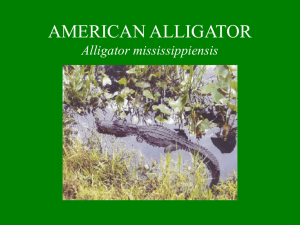
![Chapter Overview 4] Biodiversity and Evolution: Chapter Overview](http://s3.studylib.net/store/data/007156354_1-fad095015625514dd60c5e2467fa2168-300x300.png)

